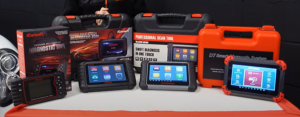If you’re a car owner, you’ve probably heard of an OBD2 scanner. An OBD2 scanner is a device that reads diagnostic trouble codes (DTCs) stored in your car’s onboard computer system. These codes can help identify problems with your car’s engine, transmission, and other components. In this article, we’ll provide a beginner’s guide to OBD2 scanners, explaining what they are, how they work, and how to choose the right one.
What is OBD2?
OBD2 (On-Board Diagnostics 2) is a standardized system that has been used in cars since the mid-1990s. OBD2 was introduced as a way to make it easier for mechanics and car owners to diagnose problems with their vehicles. OBD2 systems are required to be installed in all cars sold in the United States since 1996.
How Does an OBD2 Scanner Work?
An OBD2 scanner is a device that plugs into your car’s OBD2 port and reads the diagnostic trouble codes (DTCs) stored in the onboard computer system. The scanner can read both current and pending codes. Current codes are codes that are currently active and indicate a current problem with the vehicle. Pending codes are codes that are stored in the system but haven’t yet triggered the check engine light.
To use an OBD2 scanner, you need to locate the OBD2 port in your car, which is usually located under the dashboard on the driver’s side. Once you’ve found the port, you need to plug the scanner into it. The scanner will then communicate with the car’s onboard computer system to read the diagnostic trouble codes.
Types of OBD2 Scanners
There are several types of OBD2 scanners available, including handheld scanners, wireless scanners, smartphone apps, and PC-based scanners. Handheld scanners are the most common type and are relatively inexpensive. Wireless scanners and smartphone apps offer more convenience and flexibility, but they tend to be more expensive. PC-based scanners are the most advanced type and are often used by professional mechanics.
1. Handheld Scanners: Handheld OBD2 scanners are the most common type and are relatively inexpensive. They are small, portable, and easy to use. They come with a built-in display screen, which shows the diagnostic trouble codes (DTCs) and their meanings. Some handheld scanners can also provide real-time data on the performance of various engine components.

Examples of Handheld Scanners: Autel AutoLink AL319, Innova 3100j, Foxwell NT301
2. Wireless Scanners: Wireless OBD2 scanners use Bluetooth or Wi-Fi to connect to a smartphone, tablet, or other device. They offer more convenience and flexibility than handheld scanners, as they don’t require a physical connection to the OBD2 port. Most wireless scanners come with a dedicated smartphone app, which can display the DTCs and their meanings, along with real-time data on the car’s performance.
Examples of Wireless Scanners: BlueDriver Bluetooth Professional OBDII Scan Tool, FIXD OBD2 Professional Bluetooth Scan Tool, Veepeak OBDCheck BLE OBD2 Bluetooth Scanner
3. Smartphone Apps: Smartphone apps are a newer type of OBD2 scanner that are becoming increasingly popular. They are designed to work with the OBD2 port in your car and provide real-time data on the car’s performance. The app displays the DTCs and their meanings, along with other useful information, such as fuel efficiency, engine temperature, and RPMs.
Examples of Smartphone Apps: Torque Pro (Android), OBD Auto Doctor (iOS and Android), DashCommand (iOS and Android)
4. PC-Based Scanners: PC-based OBD2 scanners are the most advanced type and are often used by professional mechanics. They require a computer with specialized software to connect to the OBD2 port in your car. PC-based scanners can provide more detailed information on the car’s performance than other types of scanners. They can also perform advanced diagnostics and programming tasks that are not possible with other types of scanners.
Examples of PC-Based Scanners: ScanTool.net OBDLink MX+, Autel MaxiCOM MK808, Launch X431 Pro Mini
Which is Perfect for Beginners?
For beginners, handheld scanners and wireless scanners are usually the best options. Handheld scanners are easy to use, portable, and have a built-in display screen. Wireless scanners offer more convenience and flexibility, as they don’t require a physical connection to the OBD2 port. They also come with a dedicated smartphone app, which can display the DTCs and their meanings, along with real-time data on the car’s performance.
Ultimately, the best OBD2 scanner for beginners will depend on your needs and budget. Handheld scanners and wireless scanners are both good options for beginners, but you should choose one that has the features and capabilities you need. You should also make sure the scanner is compatible with your car’s make and model.
Choosing the Right OBD2 Scanner
When choosing an OBD2 scanner, there are several factors to consider, including cost, features, compatibility, and ease of use. For beginners, it’s usually best to choose a scanner that is easy to use and has a clear display. Some of the best OBD2 scanners for beginners include the Autel AutoLink AL319, the BlueDriver Bluetooth Professional OBDII Scan Tool, and the BAFX Products Bluetooth OBDII Scan Tool.
- Cost: OBD2 scanners come in a range of prices, from under $20 for basic models to several hundred dollars for more advanced models. The cost of the scanner will depend on the features and capabilities it offers. Beginners should look for an affordable scanner that has the features they need.
- Compatibility: Not all OBD2 scanners are compatible with all makes and models of cars. It’s important to check the compatibility of the scanner with your car before making a purchase. Most scanners will list the compatible make and model years in the product description.
- Features: OBD2 scanners come with a variety of features, from basic code reading to advanced diagnostics and programming capabilities. Beginners should look for a scanner that has the features they need, such as code reading, real-time data monitoring, and freeze frame analysis.
- Ease of Use: Some OBD2 scanners are more complicated to use than others. Beginners should look for a scanner that is easy to use and has a clear display. The scanner should also come with a user manual that is easy to understand.
- Display: The display on an OBD2 scanner is important for reading diagnostic trouble codes (DTCs) and other information. The display should be clear and easy to read. Some scanners come with a backlit display for use in low-light conditions.
- Brand: There are many brands of OBD2 scanners on the market. Beginners should look for a scanner from a reputable brand with a good track record. Some of the most popular brands include Autel, Innova, and BlueDriver.
- Warranty: A warranty is important for protecting your investment in an OBD2 scanner. Beginners should look for a scanner that comes with a warranty of at least one year. Some scanners come with a longer warranty or a money-back guarantee.
Tips for Using an OBD2 Scanner
When using an OBD2 scanner, it’s important to follow some basic safety precautions.
- Make sure the car’s engine is turned off
- The key is removed from the ignition before plugging in the scanner.
- You should also avoid touching any exposed wires or connectors.
- It’s also important to avoid common mistakes, such as misinterpreting the codes or clearing the codes before identifying the problem.
- It’s recommended that you read the owner’s manual carefully and familiarize yourself with the scanner’s features before using it.
Finally, it’s a good idea to use an OBD2 scanner regularly, even if your car is not experiencing any problems. Regular use can help you identify potential problems before they become serious issues.
Common mistakes to avoid when using an OBD2 scanner:
- Clearing codes before identifying the problem: Some users may be tempted to clear diagnostic trouble codes (DTCs) as soon as they see them, but it’s important to first identify the root cause of the problem. Clearing the codes before identifying the problem may cause the issue to return.
- Misinterpreting codes: OBD2 scanners display codes that correspond to specific issues with your car, but it’s important to interpret them correctly. Misinterpreting codes can lead to misdiagnosis and unnecessary repairs.
- Not following safety precautions: OBD2 scanners should only be used when the car’s engine is turned off and the key is removed from the ignition. It’s important to avoid touching any exposed wires or connectors to prevent electric shocks.
- Not updating the scanner’s software: Many OBD2 scanners come with software that requires updating to ensure compatibility with the latest cars and software. Neglecting to update the scanner’s software can lead to inaccurate readings.
- Using the scanner too often: While it’s important to use an OBD2 scanner regularly, using it too often can cause unnecessary wear and tear on the car’s components. It’s recommended to use the scanner only when there is a problem or as part of routine maintenance.
- Buying a cheap scanner with limited functionality: Some beginners may be tempted to buy a cheap OBD2 scanner, but these scanners may have limited functionality and may not be compatible with all car models. Investing in a high-quality scanner can save you time and money in the long run.
- Not familiarizing yourself with the scanner’s features: OBD2 scanners come with a variety of features, and it’s important to familiarize yourself with them to get the most out of your scanner. Many scanners come with a user manual that explains the different features and how to use them.
By avoiding these common mistakes, you can use an OBD2 scanner effectively and get the most accurate readings to diagnose and troubleshoot issues with your car.
Conclusion
An OBD2 scanner is a useful tool for car owners and mechanics alike. It can help you identify problems with your car’s engine, transmission, and other components. When choosing an OBD2 scanner, it’s important to consider factors such as cost, features.

